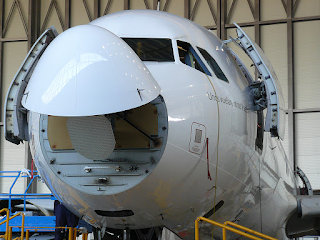A Radome is the dome-like shell that protects a radar assembly from inconvenient things like weather and moving fast. The radome’s conical shape assists the aircraft’s aerodynamics, and is made of composite materials, usually glass fibre.
Radar assemblies are fragile, moving, and in planes, usually mounted on the front. That's pretty tough to design around for efficient flight.
The open radome of an F-16 Fighting Falcon, showing off the radar (tan flat plate) and the avionics that do all the magic (boxes under the gullwing door).
On planes, radomes tend to be sleek. But fighter planes don't have a monopoly on them! Nose radome on a passenger plane, open to reveal the weather radar.
The AWS in aircraft is mostly used to detect the size of water droplets in clouds which can be used to measure the level the turbulence. To get better results the wavelength of the waves are quite small at like 3 cm (the diameter of a large water droplet). This means, it operates at quite a high frequency at approximately 9000 Mhz. Hence it is prohibited to operate the AWS near buildings and people.
A radome designer must ensure that key performance criteria are met for each of the device’s designated functions no matter what happens during flight.













ليست هناك تعليقات:
إرسال تعليق